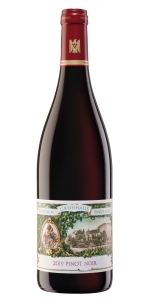Wine from Maximin Grünhaus
Weingut Maximin Grünhaus lies at the foot of a steep southern-facing cliff that extends along the left bank of the Ruwer River, roughly 2 km away from its junction with the Mosel. The vineyards of the Maximin Grünhaus estate are contiguous and enclosed. These three monopole sites (ABTSBERG, HERRENBERG and BRUDERBERG) produce grand wines that beautifully express their singular origins. A 'monopole' is a vineyard site owned and cultivated by a single estate. Although such sites are extremely rare, Maximin Grünhaus is fortunate enough to hold claim to three of them.
A Year of Precise Rhythms Our estate's cellar was built to make the grapes’ journey from vineyard to press as short as possible — usually little more than a few minutes. Following pressing and filtration, the musts are brought to their ideal fermentation temperature and readied for wild yeast fermentation in traditional oak fuder and small stainless steel tanks. In Riesling, this process encourages the herbal minerality for which the Ruwer is renowned. Each Year's Finest We send only each vintage's finest barrels for auction — no more, no less. While we typically blend multiple casks within a single quality classification, such as ABTSBERG Kabinett, we make an exception for barrels we feel best encapsulate a wine's ideal. They are instead left unblended and reserved for auction under their specific cask numbers.
Carl von Schubert Maximin Grunhaus Pinot Noir is made from 100 percent Pinot Noir.
A concentrated yet elegantly refined Pinot Noir grown in the blue slate soils of the Grosse Lage (grand cru) Abtsberg vineyard.
Review:
- back
Selected Options
Wineries
Categories
Pricing
Countries
Regions
Grape Types
Wineries
Organic/Free Shipping
All older vintage wines have been purchased from a single collectors cellar. Pictures can be requested before shipment.
Corinne Perchaud Chablis 1er Cru Fourchaume is made from 100 percent Chardonnay
Elegant citrus aromas. Concentrated and finessed, combining flavors of dried fruit with slight hints of woody notes. Perfect balance between body and acidity, long and persistent finish. This one is drinking great now, but as with all exceptional Chablis, it is possible to pay it down for years to come.
Made from 35 year old vines. The owners take great care to produce exceptional Chablis wine by keeping the lively Chardonnay fruit and the unique mineral quality imparted by the Kimmeridgian soil, the fruity acidity and bouquet in perfect balance. The grapes are harvested by hand and gently pressed in a horizontal pressoir to ensure the fullest extraction and range of flavors and aromas.
Pair with Scallops Jacques cream, roast veal with oyster mushrooms.





